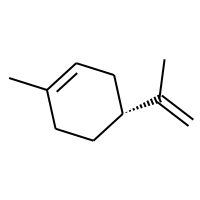
D-Limonene
| Chemical identification | |
|---|---|
| Pubchem identifier | 440917 |
| CAS identifier | 5989-27-5 |
| DSSTOX identifier | DTXSID1020778 |
| IUPAC name | D-Limonene |
| SMILES | CC1=CCC(CC1)C(=C)C |
| InChI | InChI=1S/C10H16/c1-8(2)10-6-4-9(3)5-7-10/h4,10H,1,5-7H2,2-3H3/t10-/m0/s1 |
| InChIKey | XMGQYMWWDOXHJM-JTQLQIEISA-N |
| Synonyms | Cyclohexene, 1-methyl-4-(1-methylethenyl)-, (R)-; Cyclohexene, 1-methyl-4-(1-methylethenyl)-, (theta)-; (+)-4-Isopropenyl-1-methylcyclohexene; (R)-(+)-Limonene; D-(+)-Limonene; Glidsafe; (R)-(+)-p-Mentha-1,8-diene; D-Limonene; Biogenic SE 374; (+)-Dipentene; d-p-Mentha-1,8-diene; (+)-alpha-Limonene; (4R)-Limonene; Limonene, (+)-; d-Limoneno; Refchole; (+)-(4R)-Limonene; 1-Methyl-4-(1-methylethenyl)cyclohexene, (R)-; Kautschiin; (d)-Limonene; (R)-1-Methyl-4-(1-methylethenyl)cyclohexene; Limonene, D-; Citrene; p-Mentha-1,8-diene, (R)-(+)-; (R)-p-Mentha-1,8-diene; Cyclohexene, 1-methyl-4-(1-methylethenyl)-, (4R)-; (R)-4-Isopropenyl-1-methyl-1-cyclohexene; D-limonene [JAN]; (+)-Limonene; (+)-R-Limonene; (R)-Limonene; Carvene; Glidesafe; (+)-p-Mentha-1,8-diene; (4R)-(+)-Limonene |
| Odor profile | |
|---|---|
| Odor classes | Aromatic, Citrus, Edible oil, Floral, Herbs, Pome, Seed spices, Sweet spices, Vegetable |
| Reference | [1] |
| Presence in Children's products | |
|---|---|
| Broad category | Toys |
| Subcategory | Clay Toys, Scented Toys |
| Chemical classification based on ClassyFire | |
|---|---|
| Chemical kingdom | Organic compounds |
| Chemical super-class | Lipids and lipid-like molecules |
| Chemical class | Prenol lipids |
| Chemical subclass | Monoterpenoids |
| Natural source for the chemical | |||
|---|---|---|---|
| Organism | Kingdom | Genus | Family |
| Anethum spp. | Plantae | Anethum | Apiaceae |
| Coriandrum sativum | Plantae | Coriandrum | Apiaceae |
| Mangifera indica | Plantae | Mangifera | Anacardiaceae |
| Citrus unshiu | Plantae | Citrus | Rutaceae |
| Citrus reticulata | Plantae | Citrus | Rutaceae |
| Reference | [1], [2], [3] | ||